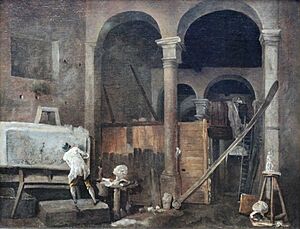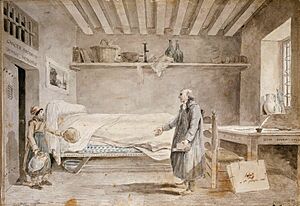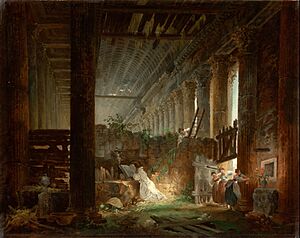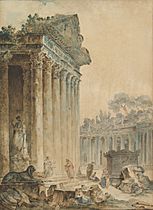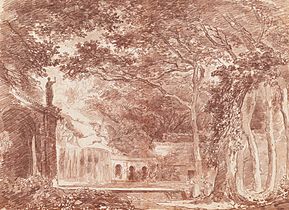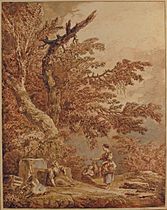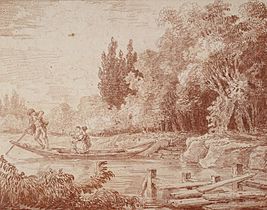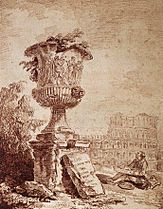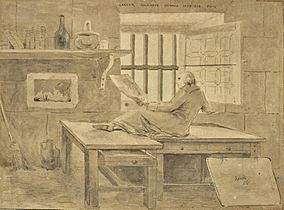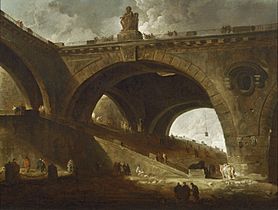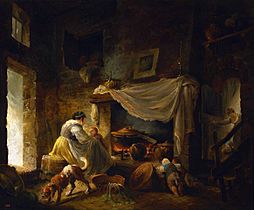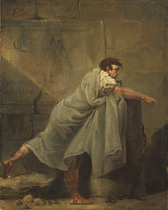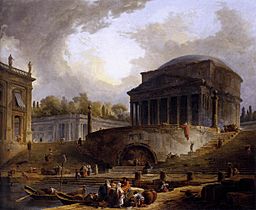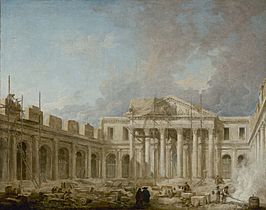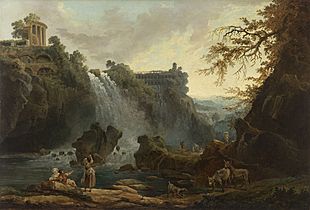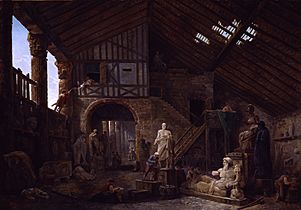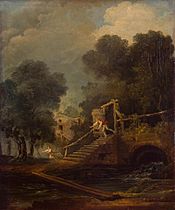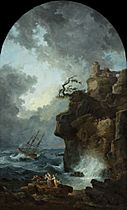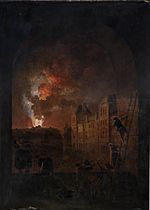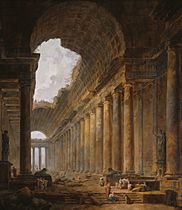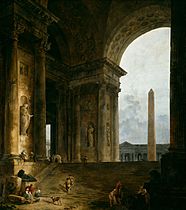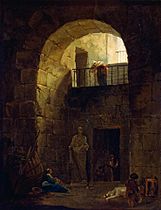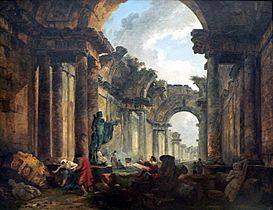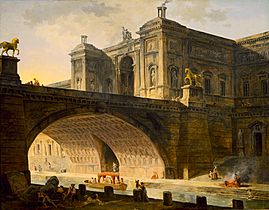Hubert Robert facts for kids
Quick facts for kids
Hubert Robert
|
|
|---|---|
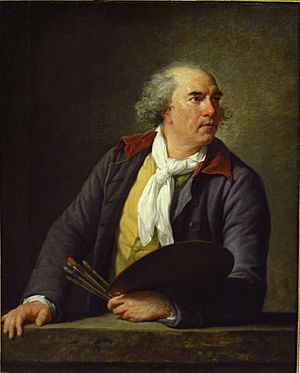
Hubert Robert by Élisabeth Vigée-Lebrun
|
|
| Born | 22 May 1733 Paris, France
|
| Died | 15 April 1808 (aged 74) Paris, France
|
Hubert Robert (born May 22, 1733 – died April 15, 1808) was a famous French painter. He was known for his beautiful landscape paintings. He also created capricci, which are imaginary scenes. These often showed ruins in Italy and France in a picturesque way. His art style is part of the Romanticism movement.
Contents
Biography
Early Life and Studies
Hubert Robert was born in Paris, France, in 1733. His father worked for a very important person, François-Joseph de Choiseul. Choiseul was a leading diplomat, a person who represents their country in foreign affairs.
Young Robert finished his studies with the Jesuits in 1751. Then, he joined the studio of a sculptor named Michel-Ange Slodtz. Slodtz taught him about design and perspective. He also encouraged Robert to become a painter. In 1754, Robert traveled to Rome. He went with Étienne-François de Choiseul, the son of his father's boss. Étienne-François later became an important government official.
Time in Rome
Hubert Robert stayed in Rome for eleven years, which was a very long time. After his official studies at the French Academy in Rome ended, he earned money by painting for wealthy art lovers. One of these was the abbé de Saint-Non. He took Robert to Naples in 1760 to see the ancient ruins of Pompeii.
The director of the King's Buildings in France, the marquis de Marigny, kept track of Robert's progress. He encouraged artists to sketch outdoors, from nature. Robert loved this and drew many famous places like the Villa d'Este.
Robert was very interested in how the old ruins of ancient Rome looked next to the everyday life of his time. He worked for a while with a painter named Giovanni Paolo Panini. Panini's style influenced Robert's painting Imaginary View of the Louvre Gallery in Ruins. Robert also spent time with artists around Piranesi. Piranesi's paintings of romantic, overgrown ruins greatly influenced Robert. This led to Robert being nicknamed Robert des ruines (Robert of the Ruins). The many sketches he made in Rome gave him ideas for his paintings throughout his life.
Return to Paris
When Robert returned to Paris in 1765, he quickly became successful. The next year, he was accepted into the important Académie royale de peinture et de sculpture. He showed a painting of a Roman scene called The Port of Rome.
Robert's first art show at the Salon in 1767 featured thirteen paintings and many drawings. The famous writer Denis Diderot was very impressed. Robert continued to show his work at almost every Salon until 1802. He was given important jobs like "Designer of the King's Gardens" and "Keeper of the King's Pictures." He also became a "Keeper of the Museum and Councilor to the Academy."
During the French Revolution, Robert was arrested in October 1793. He was held in prison for ten months. While in prison, he made many drawings and painted at least 53 canvases. He also painted small scenes of prison life. He was set free just one week after the fall of Robespierre, a leader of the Revolution. Robert was very lucky. Another prisoner with a similar name was executed by mistake instead of him.
After his release, he joined a committee of five people. Their job was to manage the new national museum at the Palais du Louvre.
The Revolution also led to some of Robert's artworks being destroyed. For example, his painting Péché Cardinal (around 1799) is believed to be lost. Robert had designed the decorations for a small theater at the Palace of Versailles. This theater was built in 1785 and opened in 1786. It was meant to be a regular court theater. However, it was destroyed later. Robert died from a stroke on April 15, 1808.
Artistic Style and Impact
Hubert Robert created a huge amount of art. He made about one thousand paintings and ten thousand drawings. The Louvre museum in Paris has nine of his paintings. You can also find his works in other museums and private collections. Robert's art often has a dramatic, scenic feel. This is why the writer Voltaire chose him to paint decorations for his theater.
Many of his works were copied as engravings by the abbé de Saint-Non. Robert had visited Naples with Saint-Non and Fragonard when he was younger. His art was also copied by other artists in Italy.
Robert was known for how lively and detailed his paintings were. He was good at painting both small pictures and very large decorations. He worked quickly, often painting directly onto the canvas without much preparation. Besides being a busy artist, his brave personality and many adventures made him admired. The writer Jacques Delille even wrote about Robert's amazing escape when he got lost in the catacombs.
Robert and Garden Design
Hubert Robert was very creative and productive. He also worked like a modern-day art director. He helped design fashionable, natural-looking gardens for rich clients. One example might be his work at Ermenonville. Here, he would have worked with an architect named Jean-Marie Morel.
In 1786, he started working at Château de Méréville with a very important supporter, Jean-Joseph de Laborde. Robert's role in garden design was not to make detailed plans. Instead, he provided artistic ideas for the mood and feeling of the gardens. His paintings often showed and inspired these garden designs.
Robert's name is also linked to the informal garden at the Petit Trianon for Marie Antoinette. He helped create the setting for the petit hameau (little hamlet). Robert's paintings of the Moulin Joly showed the beautiful, mature atmosphere of a garden that had been growing since 1754. His paintings for Bagatelle were not the direct inspiration for its formal gardens. However, they influenced later, more natural-looking additions. Robert also painted the changes happening at the park of Versailles. This painting showed the trees being cut down in 1774. Robert was definitely responsible for the design of the grotto and waterfalls called the 'Baths of Apollo'. These were built to hold a famous sculpture group.
Gallery
Works on paper
Oil paintings
-
The Pantheon with the Port of Ripetta (1766).
-
The Bastille in the Early Days of Its Demolition (1789).
See also
 In Spanish: Hubert Robert para niños
In Spanish: Hubert Robert para niños


